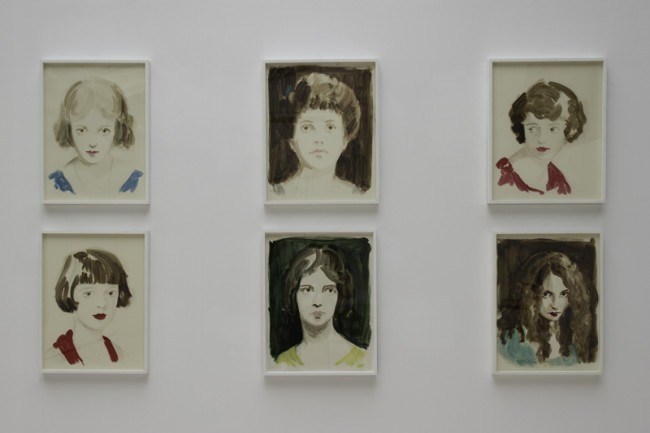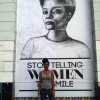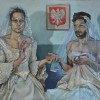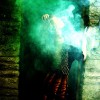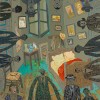British artist Annie Kevans is currently exhibiting a series of portraits of a 1920’s talent competition run by the Western Association of Motion Picture Advertisers that was entitled the WAMPAS baby stars in a group show at Cecelia Brunson Projects, with Boo Ritson and Francisca Valdivieso. The WAMPAS were an annual collection of 13 debutantes tipped to be the next big thing in the bustling glamour of the West Coast movie industry. Entitled Curiouser and Curiouser: Fantasies as Escape, the exhibition is based on the theme of dream and fantasy. The works in the show, which vary from painting, photography and porcelain, unite to form a compendium of the wonderful, the poignant and the uncanny in this thoughtfully curated show.
Born in Cannes, France Kevan’s currently lives in London. Her work features in the collections of David Roberts and Charles Saatchi in London, and in the Sonder Collection in the United States. She has had solo exhibitions at Perry Rubenstein Gallery, New York, The Fine Art Society, London, and Antonio Ferrara, Vienna, amongst others, and has also participated in group shows at the Saatchi Gallery, Victoria & Albert Museum and the Royal Academy.
Gowri Balasegaram: How did you get the idea for the [WAMPAS] series?
Annie Kevans: It came from the Girls series – the series about sexualisation of girls through the media. In that series I included very early child stars like Shirley Temple and Baby Peggy. From that, I did a series about earlier stars from the beginning of film called Vamps and Innocents. Basically, women were typecast into either vamps who usually got her comeuppance and died, or innocents who actually quite often died too – the virgin/whore syndrome. The WAMPAS series was an offshoot of that series.
I also found it very interesting that in Hollywood at the beginning of cinema, there was this idea that audiences couldn’t differentiate between actresses and the parts they played. So for example, one actress famously played little girls till she was 45, because it was assumed that was what audiences knew of her: an actress that plays girls.
GB: It sounds so weird to us now, but I suppose there were a different set of rules then.
AK: Yes, I don’t think they [the studios and directors] understood what the public understood about film.
GB: What is the WAMPAS series about?
AK: An association called the WAMPAS was set up [in the early 1920s] by some film studios and directors to create what they thought was a good influence with films. And they tried to decide – or dictate – what they thought an American should look like. There was a lot of immigration into America at the time and there was quite a fierce battle going on about what or who was an American. So they picked the girls whom they thought looked like the ideal American.
GB: The WASP [White, Anglo-Saxon, Prodestant] type?
AK: Yes, white, protestant, healthy, beautiful. Many were just models or pretty girls. Some came from a humble theatrical background, others had parents who were actors. The girls were launched to the world at this annual event called the Frolic. I read that some of directors slept with the girls and they were often used and abused. Actually, with the exception of Joan Crawford and Ginger Rogers, very few of them ever made it.
GB: Why do you think that was?
AK: I think because the girls weren’t actually actors. They were picked purely for their looks, or because the directors just fancied them. A lot had tragic ends: some committed suicide, one was found cleaning hospitals. Also, when the talkies came in, many just weren’t suitable, some, for example, because they had foreign accents. So they were cast aside. I found the idea that they were completely forgotten about quite sad, all the promise of fame and celebrity. Many of them were also very young, in their teens.
GB: It’s interesting the way you use portraiture to call to attention quite difficult subjects like power or manipulation or Foucauldian systems of thought. Could you talk a bit more about it?
AK: Portraiture has always interested me. I kept reading that portraiture, or rather figurative art, was old-fashioned or dead. I kept wondering how that was possible, because while we’re human beings we’re always going to do work about ourselves. It’s ridiculous to say there’s no room for it, [portraiture] is not just about capturing a likeness, or about representation, or photography. What’s interesting to me is the way portraiture is very familiar as a language, and for example in some of my series, the portraits are not real. They’re not really based on what people looked like.
GB: How do you decide if you’re going to paint from photographs or from your imagination?
AK: It’s more a case of when there are no images of people. When I was doing the Boys series [portraits of dictators as boys and Kevans’ first series], I couldn’t find any images for quite a lot of them. Franco, Stalin and Hitler, yes, but others like Milosevic were more difficult. I realised that the likeness wasn’t really the point of the series; it was more about the concept. And that’s how it started. What’s really interesting is that no one ever questions if they’re true. When I did a show in New York, All The President’s Girl’s, someone asked me how I got the photos of Tomas Jefferson’s children. But photography had barely been invented then! With portraiture you can tell stories. No one questions it.
GB: I wanted to ask you about your style of painting. To me, it’s simple and fluid, almost ethereal, and almost belies the depth of the concept. Could you talk a bit more about it?
AK: I use oils to create this transient, ethereal feel. I didn’t want to get bogged in layers and layers of paint, where it’s about heavy portraiture. I wanted the work to be more about the concept. With the Boys series, I liked the idea of fleeting thoughts – doing each one quickly and then moving onto the next. When I was studying art [at St. Martins] there were certain colleges which were they strict about painting, and all the paintings then [ended up] looking the same. What was great about St. Martins was that they were really focused about the idea.
GB: Have you tried painting the portraits on canvas?
AK: Yes, I first tried doing them on canvas, but it didn’t work. But I’m going to try again, because they don’t really make the [Somerset] paper anymore.
GB: In your paintings there’s just the minimum detail, but the personality is succinctly captured. Do you do many drafts?
AK: Some of them work straight away, some don’t. With the Boys series, which was my first one, I was doing some of them about 25 times each. Now I can get the effect after about 3 or 4 times.
GB: You’re obviously really interested in history and unearthing about stories from it. Are there any specific genres in history that you’re interested in?
AK: No, it’s more about when I read something that shocks me, or when I come across things that people take for granted. For example, the sexualisation of children: we’re so used to seeing it in the media and it’s come to be accepted, although we’re not happy about it. I’m interested in how that belief comes about, and the origin of it.
GB: What ‘s next?
AK: I’m doing a show in spring in the Fine Art Society called the History of Art, about the successful female artists in the last 500 years that have been written out of history by men. When I was younger, I had this idea that women couldn’t be artists because there were so few women artists remembered by history.
